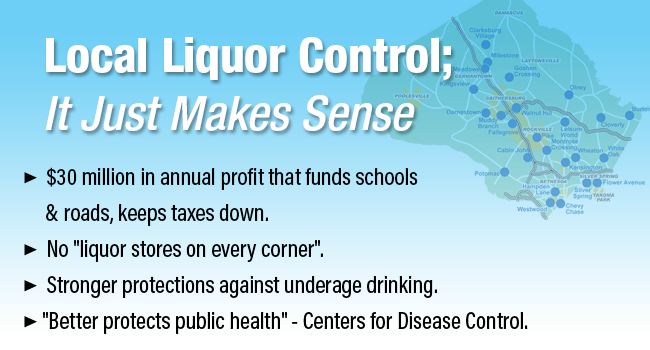
All jurisdictions “control” the sale of alcohol in some way and about one-third of Americans live in jurisdictions with systems similar to that of Montgomery County.
- Local liquor operations in Montgomery County doesn’t cost taxpayers a dime. In fact, it contributes an average of $30 million in annual profit. This money stays in the County working for us – not in the pockets of the liquor interests. It helps us fund schools, transportation, and help for the vulnerable in our midst.
- The proposed privatization scheme would eliminate $30 million profits to the County -- with nothing to replace it. The State of Maryland and the private interests – not the County – would get all the revenue generated by any increased sales, sales taxes and the liquor tax.
- Replacing $30 million in the County budget will mean substantially cutting County programs and services and/or will mean increasing property taxes annually for every County household by an additional $100 or more.
- Over the last years the County has issued more than $100 million in Local liquor bonds, pledged to be paid for by County liquor revenue. These bonds have supported important County road and infrastructure projects.
- Under the privatization scheme proposed the County would be in violation of our bond obligations and would have to replace or repay the bond holders using other county resources since the ongoing revenue supporting those bonds would no longer exist. Not only would this $100 million impact negatively the County’s capital spending on other projects, it would also hurt the County’s bond rating, potentially increasing County costs in the future.
- Just in schools alone, projects that would be eliminated or delayed in the upcoming CIP include: classroom additions at East Silver Spring, Greencastle, Montgomery Knolls, Pine Crest, Piney Branch, and Woodlin, Ashburton and S. Christa McAuliffe Elementary Schools; additions at Col. E. Brooke Lee, Thomas W. Pyle, and Takoma Park middle schools, and Walt Whitman High School. MCPS is growing at more than 2,800 students per year. Over the past five years, MCPS has completed 19 revitalization/expansion projects that have added 180 classrooms and more than 4,000 seats for students. That will not happen in the next five years if privatization occurs.
- Privatization would not create real competition. Under Maryland state law, two wholesalers may not distribute the same product in the same market at the same time. There is always one approved, designated wholesale distributor in a given market for each brand or product. Private liquor will have its own liquor monopoly.
- Privatization would not allow grocery and chain stores to sell beer and wine. Privatization of County liquor control would not affect that at all. Such sales are illegal throughout the State of Maryland, with the exception of some limited grandfathered locations.
- Privatization would hurt public health and create additional enforcement challenges for County police. According to the NIH website: “Privatization commonly results in increases in the numbers of off-premises outlets...Increased alcohol outlet density is also associated with increases in social harms, including interpersonal violence and vandalism.” When Washington State privatized their liquor system in 2012, the number of alcohol outlets increased from 328 to 1,415 – by more than 400 percent. Ill effects to public health also skyrocketed.
- According to a presentation by Johns Hopkins to the County Council this year, Montgomery County has the second lowest rate among all Maryland counties in alcohol related treatment admissions and the second lowest rate of alcohol-related crashes. In addition, the County has lower rates of youth binge drinking and alcohol- related hospitalizations and emergency room visits.
- With Montgomery’s Local Liquor operations, there are not “liquor stores on every corner” – and yet the system includes nearly 200 mom-and-pop small businesses selling beer and wine, alongside County retail stores. The system provides a wide range of products at competitive prices – while having the power to exclude liquor industry products designed primarily to promote underage drinking. We make it harder for underage individuals to purchase and provides more education for the public and for servers as well.
- Our Department of Liquor Control is working hard to improve its operations and to provide better service and better products. We have heard our customers loud and clear. They want better selection and faster service both in the stores and in restaurants. DLC’s Action Plan is already producing significant, tangible results. One strategy for expanding selection and service is legislation (Bill MC 7-16) that will reform “special orders” and give County restaurants and retail outlets more options for ordering higher-priced beer and wine products.
Materials
- Thank You flyer

- Chart Comparison of Costs to licensee from Montgomery vs Cost From Md. Wholesalers December Journal

- Privatization: What the research literature says

- Just Four Examples of How Montgomery County’s Local Liquor Control Uniquely Protects County Consumers from Dangerous Products

- 2014 ISSUE BRIEFS FOR STATES Brief Explanations of Common Alcohol Regulatory Issues Facing State and Local Communities.

- Control State Politics; Big Alcohol’s Attempt to Dismantle Regulation State by State.

- New Research Supports Alcohol-Control States.
- Alcohol Beverage Control Jurisdictions; A Community Choice.

- The Fiscal and Social Effects of State Alcohol Control Systems.

- Local Control of Alcohol Retail Availability in Wisconsin: a Legal Analysis (Dec 2011)

- The Dangers of Alcohol Deregulation: The United Kingdom Experience

- Memorandum from Timothy L. Firestine, Chief Administrative Officer to Chris Cihlar, Director of Office of Legislative Oversight on February 4, 2015.

- Review of Alcohol Control in Montgomery County (Report Number 2015 - 6, from Office of Legislative Oversight).

- Latino Business Owners Take County’s ALERT Class.
Download Liquor Facts (pdf) Letter from County Executive to BCC Chamber of Commerce (pdf) Control Jurisdiction Frequently Asked Questions (pdf) Better to Own or to Regulate? The Case of Alcohol Distribution and Sales Montgomery County – Alcoholic Beverages – Class A Beer, Wine, and Liquor Licenses and Purchases From Licensed Wholesalers. MC3-16 (pdf) Advice memo to Montgomery Co. related to MC 7-16 Purchase From the Department of Liquor Control Exception for Wholesalers (pdf) Worcester Proposes Eliminating Liquor Department In 2017; Exit Strategy Might Cost County $2.3 Million DLC wholesale price comparison for Council Sessions - June, 2015 (pdf) DLC wholesale price comparison for Council Sessions - March, 2015 (pdf) Effects of Alcohol Retail Privatization on Excessive Alcohol Consumption and Related Harms: Studies & Recommendations Montgomery County, MD Department of Liquor Control Union Positions, FTE's and Salary/Benefits Liquor Control May Be On The Way Out In Montgomery County — But Is It Really More Expensive? (NPR)
